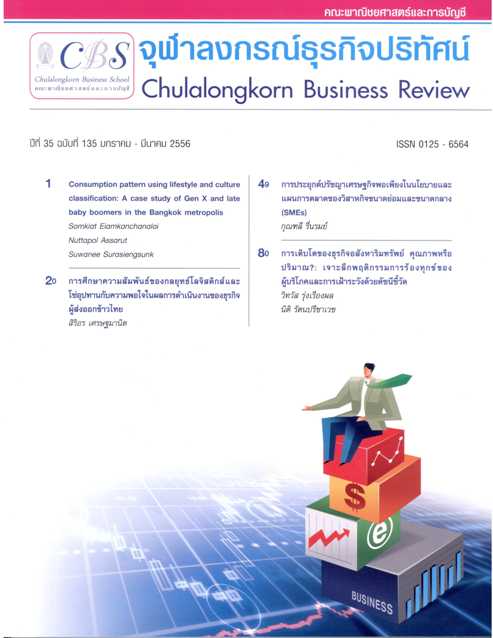Consumption pattern using lifestyle and culture classification: A case study of Gen X and late baby boomers in the Bangkok metropolis
Main Article Content
Abstract
เนื่องจากประชากรกลุ่มเบบี้บูมได้ก้าวเข้าสู่ช่วงวัยเกษียณอายุมากขึ้น ส่งผลให้ความสนใจของนักการตลาดได้เปลี่ยนไปโดยมุ่งตรงไปยังกลุ่มเจเนอเรชั่นเอ็กซ์และกลุ่มเบบี้บูมตอนปลาย ซึ่งมีช่วงอายุระหว่าง 40 ถึง 50 ปีมากขึ้น ด้วยความแตกต่างของรูปแบบการดำเนินชีวิตและวัฒนธรรมที่คนเหล่านี้มีเมื่อเทียบกับกลุ่มเบบี้บูม ทำให้มีความจำเป็นที่ต้องศึกษาเพิ่มเติมเพื่ออธิบายพฤติกรรมการบริโภคในอนาคตของพวกเขาเหล่านี้ โดยเฉพาะอย่างยิ่งเมื่อยามที่พวกเขาเข้าสู่วัยเกษียณอายุ ด้วยเหตุนี้ งานวิจัยนี้จึงมีวัตถุประสงค์เพื่อประยุกต์นำแนวคิดรูปแบบวิถีชีวิตและวัฒนธรรมมาใช้ในการแบ่งกลุ่มผู้บริโภคกลุ่มนี้ อันจะช่วยให้สามารถเข้าใจความคิดและความชื่นชอบของกลุ่มคนเหล่านี้ได้ดียิ่งขึ้นกว่าการแบ่งกลุ่มประชากรโดยใช้เกณฑ์ด้านประชากรศาสตร์เพียงอย่างเดียว จากกลุ่มตัวอย่างจำนวน 600 ตัวอย่าง ได้ทำการวิเคราะห์ข้อมูลโดยใช้การวิเคราะห์จำแนกกลุ่มแบบ 2 ขั้น ได้ผลว่าสามารถแบ่งกลุ่มกลุ่มตัวอย่างออกได้เป็น 5 กลุ่มหลัก และ 14 กลุ่มย่อย โดยกลุ่มตัวอย่าง 5 กลุ่มหลักได้แก่ กลุ่มพนักงานบริษัท กลุ่มผู้ใช้แรงงาน กลุ่มผู้มีธุรกิจส่วนตัว กลุ่มครอบครัวตัวอย่าง และกลุ่มรักสันโดษ โดยกลุ่มตัวอย่างแต่กลุ่มมีการให้ความสำคัญในรูปแบบการบริโภคเกี่ยวกับด้านสุขภาพมากเป็นอันดับที่หนึ่ง รองลงมาคือ ด้านที่พักอาศัย ด้านเศรษฐกิจ ด้านจิตใจ และด้านการใช้เวลาว่าง ตามลำดับ ผลลัพธ์ที่ได้จากงานวิจัยนี้สามารถช่วยเสนอแนะแนวทางการทำการตลาด และการจัดการด้านต่าง ๆ ได้
คำสำคัญ: รูปแบบการบริโภค วัฒนธรรม รูปแบบวิถีชีวิต การเกษียณอายุ การส่วนตลาด
Abstract
As the baby boomer generation has moved into retirement age, the focus of marketers has now shifted toward Gen X and the late baby boomer generation - people in their 40s and 50s. With differences in their lifestyle and culture, their behavior must be investigated to explain how their future consumption will change. This study suggests an incorporation of lifestyle and culture factors to classify these generations to gain their insights and preferences rather than using the traditional demographic classification alone. A sample of 600 respondents is studied. The two-step cluster analysis divides the respondents into 5 main groups and 14 individual groups. The 5 main groups are: company employee, worker, self-employed, model family and solitary. The priority of their consumption pattern is physical health, housing, economics, mental health and leisure time spending respectively. Marketing and managerial implications are suggested.
Keywords: Consumption pattern, culture, lifestyle, retirement, segmentation
Article Details
Opinions and discussions in papers published by the Creative Business and Sustainability Journal (CBSJ) are deemed as personal opinions and the responsibility of the writers. They are not the opinions or responsibility of the Chulalongkorn Business School of Chulalongkorn University.
Papers, content, information etc. appearing in the Journal are deemed to be the copyright property of the Chulalongkorn Business School of Chulalongkorn University. Anybody or any organization that wishes to publish any part of them or use them in any way must obtain written permission from the Chulalongkorn Business School, Chulalongkorn University.


